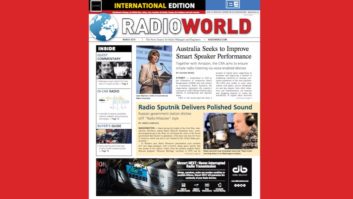Back during the height of the First Cold War, international shortwave station Radio Moscow broadcast news, views, and programming to the West; all reflecting the views of the Soviet government that funded its operations. (The same was true for Voice of America, which was and is still funded by the United States government.)

To Western ears, Radio Moscow’s presentation style sounded stiff and stage-managed, with a hollow, sharp audio quality that was unique to this station. Audio from the globally popular Radio Moscow program “Moscow Mailbag,” recorded in 1979, can be found here.
This distinctive style and sound quality made it easy for shortwave radio listeners scanning the bands to identify Radio Moscow’s English service.
It is 2019, and Radio Moscow has morphed into Radio Sputnik. And although the Kremlin is still paying the bills, Radio Sputnik’s presentation is as polished as any Western radio station.

In Washington D.C., Radio Sputnik produces its content in a K Street office — the same street that is home to many American lobbying firms — and broadcasts it locally via 105.5 FM and 1390 AM (MW). Radio Sputnik also has broadcast studios in Edinburgh and Moscow.
“I hope you are right and we are a long way from Radio Moscow in terms of our technical capabilities and echoing sound as well,” said Mindia Gavasheli, Editor-in-chief of Sputnik US, in response to emailed questions from Radio World International. “This is why it was so important for us to be heard in Washington D.C. on an FM station.”

Another difference between the two Kremlin-funded broadcasters is that “Radio Moscow was created from Moscow by Russians who had very little understanding of what life in the U.S. is like,” Gavasheli noted. “In our Washington, D.C. office, radio is done by Americans and mostly for Americans, even though we broadcast internationally.”
Radio Sputnik is also modern: Beyond being on air in Washington D.C. at 1390 AM and 105.5 FM, Radio Sputnik offers multimedia content online at https://sputniknews.com/radio. There’s even a free “Sputnik app” available for both Android and Apple smartphones.

To deliver this high level of radio production, Radio Sputnik employs a top-quality radio production infrastructure. It includes Wheatstone’s LX-24 and L-12 audio mixers, ip88-3m analog input/output BLADE with mic-level inputs; M4IP-USB four-channel BLADE mic processor; digital engine blade; digital console blade; Neumann BCM 104 cardioid broadcast mics; Pro Tools and Samplitude digital audio workstations; Trakt DJin broadcast software; an RME Fireface 802 sound card and Genelec studio monitor loudspeakers.
The sophistication of Radio Sputnik’s IP-enabled production system has definitely raised the bar on its production capabilities, and its ability to do out-of-office remotes. For instance, “When Fidel Castro died, we thought that offered a rare opportunity for us to tell people around the world more about Cuba based on first-hand experience,” said Gavasheli. “So we packed and flew to Havana to cover the country as it was mourning its former leader.”
Read: Nordjyske Medier Covers Northern Denmark With Remotes
By adeptly using modern technology and production techniques, Radio Sputnik has raised Russian international broadcasting to high standards; an accomplishment that the station’s predecessors at Radio Moscow would most likely be proud of.







